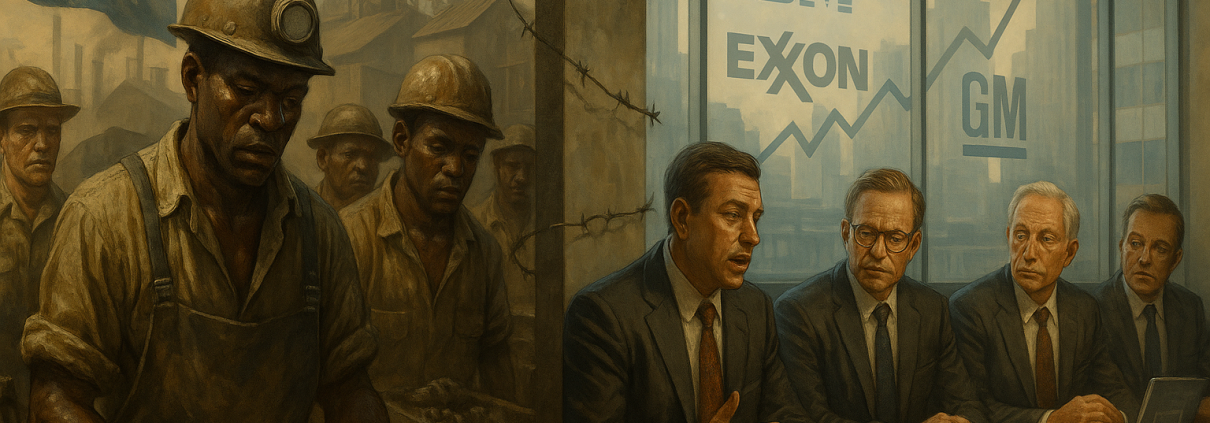Apartheid in South Africa and US Businesses Who Profited Despite Human Rights Violations and Killing & Torture of Blacks in SA
By Esther Claudette Gittens | Photo Copyright IQ INC.
The abhorrent system of apartheid in South Africa, a brutal institutionalization of racial segregation and discrimination, cast a long shadow over the latter half of the 20th century. While the international community largely condemned this regime, the role of the United States of America was far more nuanced and, at times, complicit. For decades, a complex interplay of Cold War geopolitics, economic interests, and a gradual but powerful domestic anti-apartheid movement shaped Washington’s stance, ultimately leading to a shift from tacit support and “constructive engagement” to targeted sanctions. This article will analyze the multifaceted role of the USA in sustaining the apartheid system and identify the numerous US corporations that directly benefited from its exploitative practices.
The Cold War Calculus: Prioritizing Geopolitics over Human Rights
In the immediate aftermath of World War II and throughout the early Cold War, US foreign policy was heavily influenced by the global ideological struggle against communism. South Africa, with its strategic location, vast mineral wealth (including uranium), and staunch anti-communist government, was viewed by successive US administrations as a crucial ally in the region. This geopolitical calculus often overshadowed concerns about the egregious human rights violations inherent in apartheid.
From the 1950s through the 1970s, despite rhetorical condemnations of racial discrimination, the US government largely avoided strong punitive measures against Pretoria. The Truman administration, while championing civil rights domestically, chose not to protest apartheid vigorously, prioritizing the alliance against the Soviet Union. This set a precedent for subsequent administrations, which often quietly supported the apartheid regime or, at best, offered mild criticism while blocking stronger international sanctions at the United Nations. For instance, in the 1960s and 1970s, the US, alongside other powerful Security Council members, consistently watered down proposals for mandatory sanctions against South Africa.
This approach reached its zenith under President Ronald Reagan’s administration in the 1980s with the policy of “constructive engagement.” The premise was that gentle diplomatic pressure and continued economic ties, rather than isolation, would encourage the white minority government to reform. Critics, however, widely viewed “constructive engagement” as a de facto endorsement of apartheid, providing the regime with international legitimacy and economic lifelines. This policy allowed US businesses to continue operating and profiting within South Africa, further entrenching American economic interests in the apartheid state.
Economic Entanglement: US Corporations and the Fruits of Exploitation
The economic ties between the United States and apartheid South Africa were extensive and highly profitable for American corporations. By the late 1970s, approximately 350 US companies maintained direct operations in South Africa, including a significant number of Fortune 100 firms. The total US direct investment in South Africa surged from $500 million in 1960 to $2.6 billion by 1983, a 400% increase. Beyond direct investment, thousands more US firms engaged in business with South Africa through various means.
These US corporations were strategically positioned in vital sectors of the South African economy, including manufacturing, petroleum production, mining, computers, high technology, and heavy engineering. The allure for these companies was clear: exceptionally high profit margins. While the average profit rate for US investments worldwide hovered around 11%, ventures in South Africa yielded an average return of 18.6%. This inflated profitability was directly attributable to the apartheid system’s systematic exploitation of cheap Black labor and its official policies suppressing Black labor unionization. The institutionalized racial hierarchy ensured a vast, disenfranchised workforce that could be paid meager wages, thereby maximizing corporate profits.
Key US Corporations that Benefited:
Numerous prominent American companies operated in apartheid South Africa, directly benefiting from the exploitative economic environment. While many eventually divested due to mounting pressure, their presence for decades contributed to the regime’s economic stability. Some of the most notable included:
Automotive Industry:
General Motors (GM): A major player, controlling a significant portion of South Africa’s automobile market and operating large manufacturing plants.
Ford: Similar to GM, Ford had extensive operations and a substantial market share.
Chrysler: Also invested heavily in the South African automotive industry.
Oil and Energy:
Mobil: A dominant force in the petroleum sector, controlling a large share of the oil market and refining capacity.
Caltex: A joint venture of Texaco and Standard Oil of California, also a major player in oil import, refining, and marketing.
Exxon: Another significant presence in the South African oil market.
Fluor Corporation: A California-based engineering and construction company awarded major contracts for the expansion of SASOL coal-to-oil conversion plants, crucial for South Africa’s energy self-sufficiency amidst international sanctions.
Technology and Manufacturing:
IBM: A leading provider of computers and technology, essential for government and business operations.
3M: Involved in various manufacturing and technology sectors.
National Cash Register (NCR): Provided business machines and technology.
Polaroid: Faced significant anti-apartheid activism due to its film being used in the notorious passbooks, which controlled the movement of Black South Africans.
Goodyear: A major tire manufacturer.
Firestone: Another prominent tire company.
Caterpillar: Supplied heavy machinery, likely used in mining and infrastructure projects.
Allis-Chalmers: Involved in the nuclear sector, contributing to South Africa’s nuclear capabilities.
Kimberly-Clark: Operated a plant producing paper products.
Other Industries:
Allied Chemical
American Cyanamid
Gillette
International Harvester
Olin Mathieson
Procter & Gamble
Revlon
Upjohn
The Anti-Apartheid Movement and Shifting Tides
Despite the economic and geopolitical rationales for continued engagement, a powerful anti-apartheid movement gained momentum within the United States. Grassroots activism, student protests, labor union solidarity, and religious organizations exerted immense pressure on corporations, universities, and government bodies to divest from South Africa. The “Sullivan Principles,” introduced in 1977 by Reverend Leon Sullivan, a General Motors board member, were an attempt by some corporations to demonstrate ethical conduct by pledging non-segregation, equal pay, and training programs. However, critics widely dismissed these principles as insufficient and largely cosmetic, arguing they did not challenge the fundamental structures of apartheid or address Black political rights. Many companies did not even adhere to them.
The turning point in US policy came in 1986. Driven by overwhelming public and congressional pressure, and despite President Reagan’s veto, the US Congress enacted the Comprehensive Anti-Apartheid Act (CAAA). This landmark legislation imposed significant economic sanctions, including bans on new US trade and investment, and direct air links. It also provided aid to the victims of apartheid. While some argued about the exact degree of their impact, these sanctions, combined with internal resistance within South Africa and other international pressures, undeniably contributed to the economic struggles of the apartheid regime, forcing it to confront the unsustainability of its system.
The end of the Cold War further eroded the strategic justification for supporting Pretoria. With the perceived communist threat diminished, the US incentive to maintain ties with the apartheid government waned significantly. This shift in geopolitical landscape, coupled with the relentless pressure from the anti-apartheid movement and the economic squeeze of sanctions, ultimately played a crucial role in the dismantling of apartheid and the transition to a democratic South Africa in the early 1990s.
Conclusion
The United States’ role in the era of apartheid was a complex and often contradictory one. While official rhetoric frequently condemned racial discrimination, Cold War imperatives and significant economic interests led to policies that, for decades, effectively sustained the apartheid regime. US corporations, drawn by lucrative profits derived from a system built on cheap, exploited labor, were deeply embedded in the South African economy. It was only through the persistent efforts of a powerful domestic anti-apartheid movement, which successfully shifted public opinion and pressured Congress, that the US government eventually adopted meaningful sanctions. This ultimately contributed to the international isolation and economic strain that, alongside the courageous internal struggle of Black South Africans, brought an end to one of the most unjust systems of the 20th century. The legacy of US corporate involvement remains a stark reminder of how economic gain can, at times, override moral imperatives.




Leave a Reply
Want to join the discussion?Feel free to contribute!